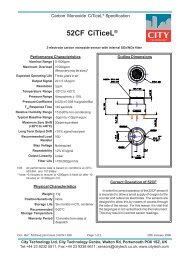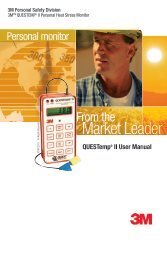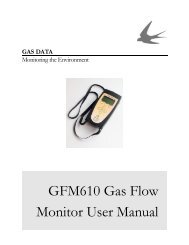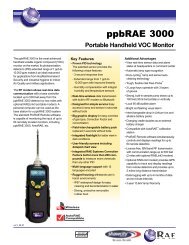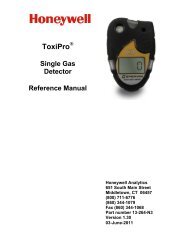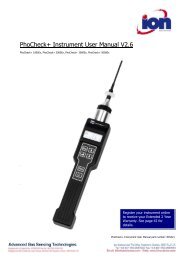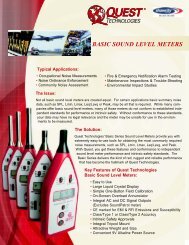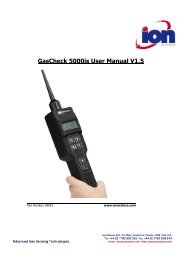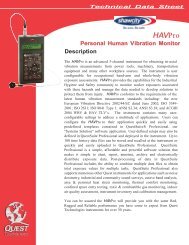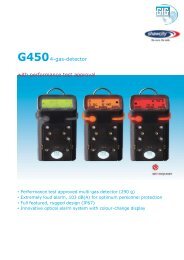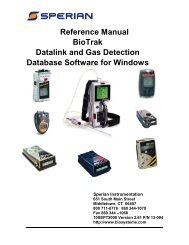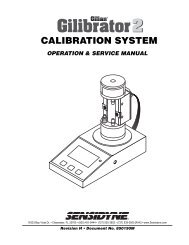Xgard Type 1 - Shawcity Limited
Xgard Type 1 - Shawcity Limited
Xgard Type 1 - Shawcity Limited
You also want an ePaper? Increase the reach of your titles
YUMPU automatically turns print PDFs into web optimized ePapers that Google loves.
English<br />
English<br />
Safety information<br />
• <strong>Xgard</strong> gas detectors must be installed, operated and maintained in strict accordance with<br />
these instructions, warnings, label information, and within the limitations stated.<br />
• <strong>Xgard</strong> detectors are designed to detect gases or vapours in air, and not inert or oxygen deficient<br />
atmospheres. <strong>Xgard</strong> oxygen detectors can measure in oxygen deficient atmospheres.<br />
• Electrochemical cells used in toxic and oxygen versions of <strong>Xgard</strong> contain small volumes of<br />
corrosive electrolyte. Care should be observed when replacing cells to ensure that the electrolyte<br />
does not come into contact with skin or eyes.<br />
• Maintenance and calibration operations must only be performed by qualified service personnel.<br />
• Only genuine Crowcon replacement parts must be used, substitute components may invalidate<br />
the certification and warranty of the detector.<br />
• <strong>Xgard</strong> detectors must be protected from extreme vibration, and direct sunlight in hot environments<br />
as this may cause the temperature of the detector to rise above its specified limits<br />
and cause premature failure. A sunshade is available for <strong>Xgard</strong>.<br />
• This equipment must not be used in a Carbon Disulphide atmosphere.<br />
Hazardous area classifications:<br />
Zone 0: An area classified as Zone 0 will have ignitable concentrations of flammable gases,<br />
vapours or liquids either continuously present or present for long periods of time under<br />
normal operating conditions. Intrinsically Safe (Exia) detectors are suitable for use in<br />
Zone 0, provided they are connected via a suitable zener barrier or galvanic isolator.<br />
Zone 1: An area classified as Zone 1 is likely to have ignitable concentrations of flammable<br />
gases, vapours or liquids present under normal operating conditions. Flameproof (Exd)<br />
detectors are suitable for use in Zone 1. Intrinsically Safe (Exia) detectors are suitable<br />
for use in Zone 1, provided they are connected via a suitable zener barrier or galvanic<br />
isolator.<br />
Zone 2: An area classified as Zone 2 is not likely to have ignitable concentrations of flammable<br />
gases, vapours or liquids present under normal operating conditions. Flameproof (Exd)<br />
detectors are suitable for use in Zone 2. Intrinsically Safe (Exia) detectors are suitable<br />
for use in Zone 2, provided they are connected via a suitable zener barrier or galvanic<br />
isolator.<br />
Notes:<br />
In North America ‘Divisions’ are used to categorise risk where:<br />
Division 1 is equivalent to Zone 0 or 1<br />
Division 2 is equivalent to Zone 2<br />
Under European ATEX rules hazardous area equipment has been re-defined under ‘equipment<br />
categories’ where:<br />
European (ATEX)<br />
Equipment Category 1 is suitable for Zone 0<br />
Equipment Category 2 is suitable for Zone 1<br />
Equipment Category 3 is suitable for Zone 2<br />
6



